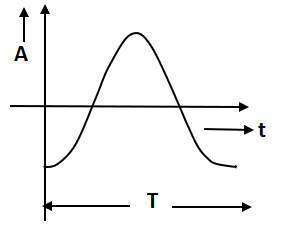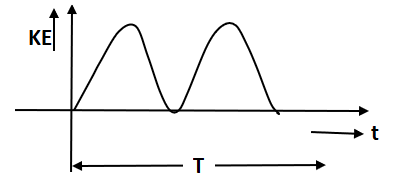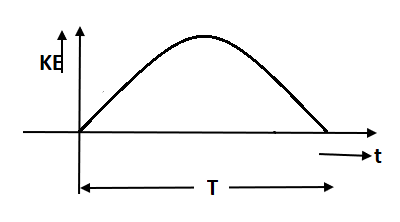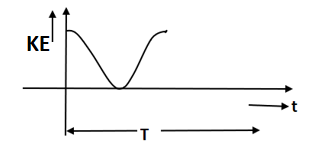
Acceleration A and time period T of a body in S.H.M. is given by a curve shown below. Then corresponding graph, between kinetic energy (K.E.) and time t is correctly represented by
A. 
B. 
C. 
D. 
Answer
218.1k+ views
Hint: In a simple harmonic motion (SHM) the distance of positive extreme position and negative extreme position from the mean position is represented as an amplitude(A). At both positive and negative extreme positions velocity is zero and acceleration will be maximum and at mean position velocity will be maximum and acceleration will be zero.
Complete step by step solution:
In a simple harmonic motion (SHM), the graph between the acceleration (A) and time period (T) of a body is given. As we know, kinetic energy (KE) depends on velocity so when the velocity of a body increases then kinetic energy of that body will also increase. When acceleration of the body becomes zero then velocity of that body will be at maximum value and thus kinetic energy will also increase.
In the given graph in the question, initially the amplitude is maximum which means acceleration is maximum and velocity is zero. Hence kinetic energy will also be zero. After some time, amplitude is shown as zero which means acceleration is zero and velocity is maximum. Hence kinetic energy will also be maximum. Similarly, again kinetic energy becomes zero at maximum amplitude and maximum at zero amplitude. Now if we compare options, the graph of option A represents the correct result.
Hence option A is the correct answer.
Note: Simple Harmonic Motion (SHM) is defined as a motion in which the restoring force(F) is directly proportional to the displacement(x) of the body from its mean position or equilibrium position. It can also be known as an oscillatory motion in which the acceleration of the body at any position is directly proportional to the displacement which is from the mean position.
Complete step by step solution:
In a simple harmonic motion (SHM), the graph between the acceleration (A) and time period (T) of a body is given. As we know, kinetic energy (KE) depends on velocity so when the velocity of a body increases then kinetic energy of that body will also increase. When acceleration of the body becomes zero then velocity of that body will be at maximum value and thus kinetic energy will also increase.
In the given graph in the question, initially the amplitude is maximum which means acceleration is maximum and velocity is zero. Hence kinetic energy will also be zero. After some time, amplitude is shown as zero which means acceleration is zero and velocity is maximum. Hence kinetic energy will also be maximum. Similarly, again kinetic energy becomes zero at maximum amplitude and maximum at zero amplitude. Now if we compare options, the graph of option A represents the correct result.
Hence option A is the correct answer.
Note: Simple Harmonic Motion (SHM) is defined as a motion in which the restoring force(F) is directly proportional to the displacement(x) of the body from its mean position or equilibrium position. It can also be known as an oscillatory motion in which the acceleration of the body at any position is directly proportional to the displacement which is from the mean position.
Recently Updated Pages
Chemical Properties of Hydrogen - Important Concepts for JEE Exam Preparation

JEE General Topics in Chemistry Important Concepts and Tips

JEE Atomic Structure and Chemical Bonding important Concepts and Tips

JEE Amino Acids and Peptides Important Concepts and Tips for Exam Preparation

JEE Extractive Metallurgy Important Concepts and Tips for Exam Preparation

Algebra Made Easy: Step-by-Step Guide for Students

Trending doubts
JEE Main 2026: Application Form Open, Exam Dates, Syllabus, Eligibility & Question Papers

Derivation of Equation of Trajectory Explained for Students

Hybridisation in Chemistry – Concept, Types & Applications

Understanding the Angle of Deviation in a Prism

Understanding Collisions: Types and Examples for Students

Understanding Atomic Structure for Beginners

Other Pages
JEE Advanced Marks vs Ranks 2025: Understanding Category-wise Qualifying Marks and Previous Year Cut-offs

Units And Measurements Class 11 Physics Chapter 1 CBSE Notes - 2025-26

NCERT Solutions For Class 11 Physics Chapter 8 Mechanical Properties Of Solids

Motion in a Straight Line Class 11 Physics Chapter 2 CBSE Notes - 2025-26

NCERT Solutions for Class 11 Physics Chapter 7 Gravitation 2025-26

How to Convert a Galvanometer into an Ammeter or Voltmeter




